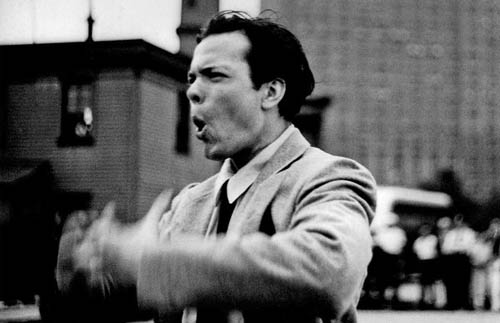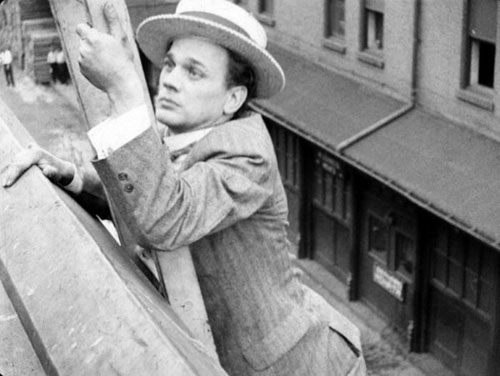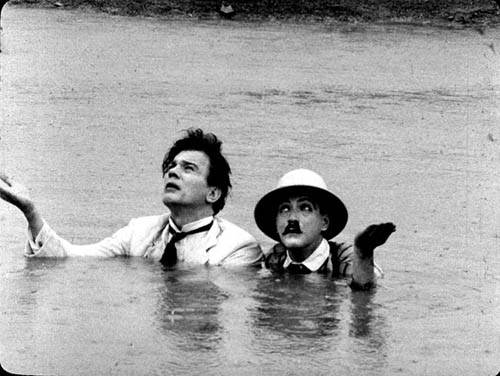오손 웰스 잃어버린 영화 찾았다
코미디 '투 머치 존슨'(1938) 75년만에 이탈리아서 발견
영화사상 최고의 걸작으로 평가되는 '시민 케인(Citizen Kane, 1941)'의 거장 오손 웰즈가 23세에 만들었던 영화가 이탈리아에서
발견되어 세상 밖으로 나왔다.
1938년 친구 조셉 키튼을 기용해 찍은 코미디 '투 머치 존슨(Too Much Johnson)'은 완성되지 못했고, 공개 상영된 적도 없었다.
이후에 화재로 소실된 것으로 전해졌었다.
'투 머치 존슨'은 욘커스의 플레이보이 오거스터스 빌링스(조셉 코튼 분)이 쿠바의 농장 주인 존슨으로 이름을 바꾸어 바람을 피운다.
어느날 빌링스가 칠레의 산티아고에 갔더니 존슨이라는 인물이 존재한다는 것을 알게되면서 겪는 해프닝을 담았다.
'투 머치 존슨'은 오는 10월 9일 이탈리아의 포르데노네에서 열리는 무성영화제 'Le Ciomate del Cinema Muto'에서 75년만에
상영될 예정이다. http://www.filmpreservation.org
 Orson Wells
Orson Wells
National Film Preservation Foundation
Lost Mercury Theatre Film by Orson Welles Found in Italy
 |
Madcap chase across the rooftops of Manhattan in Orson Welles's Too Much Johnson (1938), produced for the Mercury Theatre. CLICK HERE for more images. |
The National Film Preservation Foundation, George Eastman House, the Cineteca del Friuli, and Cinemazero today announced the recovery of Orson Welles’s long-lost Too Much Johnson(1938), filmed two years before the celebrated American director went to Hollywood to make Citizen Kane (1941).
As a member of the Mercury Theatre, Welles created the slapstick short starring Joseph Cotten, Arlene Francis, and Ruth Ford for the Theatre’s innovative 1938 production of the 19th-century play by William Gillette. Never finished, the film did not screen publicly and took on legendary status when the single known print reportedly burned. Now after 75 years, the silent comedy will finally have its debut at the famed silent film festival, Le Giornate del Cinema Muto, in Pordenone, Italy, on Wednesday, October 9, 2013.
Though barely twenty, Welles had already rocketed to national fame through his Federal Theater Project productions of “Voodoo” Macbeth and The Cradle Will Rock before cofounding the Mercury Theatre with John Houseman in 1937. Their first production, a restaging of Julius Caesar in fascist Italy, was an immediate Broadway hit. For Welles, Too Much Johnson provided another opportunity to rethink a theatrical warhorse for contemporary audiences. He turned the long-in-the-tooth marital farce of mistaken identities into a lightning-paced screwball comedy and shot three short movies to give the back story before each act.
 A.M.P.A.S.
A.M.P.A.S.
"The discovery of the long lost footage from Orson Welles's out-of-town production of Too Much Johnsonis thrilling, a very significant missing piece in the jigsaw of Welles's art,” said Simon Callow, the celebrated British actor and writer. “It was filming these sequences that first made him fall in love with film; here he began to discover the possibilities not only of shooting but of editing. It will tell us an enormous amount about his visual sensibility and indeed about his theatrical instincts; at last we can really get a sense of what this recklessly inventive production for the Mercury Theatre might actually have been like had the film been used.” Mr. Callow is now at work on the third and final volume of his definitive biography of Welles.
An abandoned 35mm nitrate work print of Too Much Johnson, found in a warehouse in Pordenone, Italy, was salvaged by Cinemazero, the film exhibition organization that partners with the Cineteca del Friuli to present the city’s annual silent film festival. Given the importance of Too Much Johnson for American stage and film history, the two organizations invited Eastman House and the NFPF to work with them to preserve the film. Eastman House directed the preservation to 35mm film, which was funded through the NFPF, and will host the American premiere on October 16, in Rochester, New York, directly after the work screens in Pordenone. The NFPF hopes to secure funding to present the film on the Internet later in the year.
 George Eastman House & Cineteca del Friuli
George Eastman House & Cineteca del Friuli
It has long been said that Paramount Pictures, which owned the film rights to Too Much Johnson, squashed Welles’s movie adaptation after he began shooting, a claim that could not be substantiated by Paramount in a recent search of its archives. Another account suggests that the highly flammable nitrate film could not be safely shown in the Stony Creek Theater in Connecticut, where the play opened. Whatever the reason for dropping the film, the play opened without it on August 16, 1938, and flopped. Undeterred, Welles went on to produce the celebrated radio broadcast of War of the Worldslater that year.
 George Eastman House & Cineteca del Friuli
George Eastman House & Cineteca del Friuli
While none of the three parts of Too Much Johnson reached final cut, the surviving footage reveals a master in the making. The longest and most finished piece, the Act 1 prologue, shows the philandering Billings (Joseph Cotten), who has been womanizing under the name of Johnson, chased at breakneck speed across Manhattan by a wronged husband. Two shorter segments establish the death of Billings’ friend in Cuba and the complications caused when too many Johnsons turn up there. A 16mm home movie from one of the Mercury Theatre’s many investors, and now at UC Berkeley Art Museum and Pacific Film Archive, documents the exuberant Welles shooting on location in the Hudson Valley.
To find out more about “lost” American films found abroad by the NFPF and available on DVD, clickhere.
 |  | ||
| About the Mercury Theatre Production, by Scott Simmon | About Our Partners | ||
 |  | ||
| Earliest footage of Welles as film director (Courtesy of BAM/PFA) | Only known footage of "Voodoo" Macbeth |
- 오손웰즈,




 한국사회 부조리와 인간의 원죄 탐구하는 감독들 뉴욕 오다
한국사회 부조리와 인간의 원죄 탐구하는 감독들 뉴욕 오다
 김기덕 '뫼비우스', 이상일 '용서받지 못한 자' 베니스 영화제 초청
김기덕 '뫼비우스', 이상일 '용서받지 못한 자' 베니스 영화제 초청

